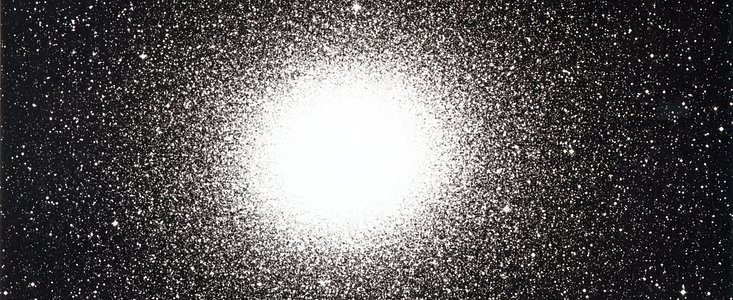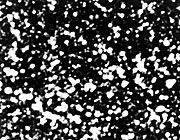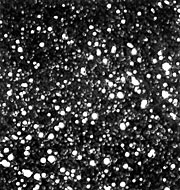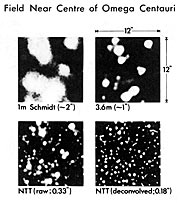Pressemeddelelse
A Revolution in Ground-Based Direct-Imaging Resolution
11. maj 1989
"First Light" with the ESO New Technology Telescope (NTT) was obtained on March 23, 1989 (eso8903) during conditions of exceptionally good "seeing'' and the first images are probably the sharpest ever obtained with a large, ground-based telescope. A full account of the associated events will appear in the June 1989 issue of the ESO Messenger.
In the meantime, the best CCD frame of the bright southern cluster Omega Centauri has been subjected to advanced image processing, further sharpening the stellar images. As an illustration of the importance of achieving the highest possible resolution, this Press Release is accompanied by four photos, which also demonstrate the great potential of the ESO New Technology Telescope (NTT), in terms of finer detail and fainter limiting magnitude, as compared to existing telescopes:
- A - Overall view of the Omega Centauri Globular Cluster (ESO Schmidt telescope), with the NTT field indicated,
- B - Reproduction of one of the best plates obtained with the ESO 3.6 m telescope, at the same scale as the NTT field,
- C - False colour reproduction of best NTT exposure with 0.33 arcsecond resolution, and
- D - Comparison between a) ESO Schmidt plate (2 arcsecond resolution), b) 3.6 m plate (1 arcsecond), c) "raw'' NTT CCD frame (0.33 arcsecond), and d) deconvolved NTT CCD frame (0.18 arcsecond).
General information about the photos is given in the figure captions and further technical details about image D follow below:
The field shown in image D is near the centre of the bright southern globular cluster Omega Centauri. It measures 12 × 12 arcseconds square and covers about 1/16 of the area of a CCD frame, obtained with the NTT on the night of "First Light''. It can easily be identified near the left edge of image C.
The upper left picture is an enlargement of a photographic plate obtained in 1984 with the ESO Schmidt telescope under atmospheric seeing conditions mediocre by La Silla standards (2 arcsec). Next (upper right) follows an excellent photographic plate obtained at the Cassegrain focus of the ESO 3.6 m telescope in 1977 with seeing 1arcsecond.
A 10 sec unfiltered CCD exposure was made with the NTT at the moment of "First Light'' on March 23, 1989. Part of it is shown below; to the lower left in the "raw" version in which the width of the stellar images (at half maximum intensity) is 0.33 arcseconds, a value never before achieved with a large, ground-based telescope. To the lower right, the same frame is shown after "sharpening'' by advanced image processing; the resolution is now improved to 0.18 arcseconds. The stellar images are noticeably sharper and faint stars are much better visible.
The first (upper left) picture is an enlargement of a photographic plate obtained in 1984 with the ESO Schmidt telescope under seeing conditions mediocre by La Silla standards (2 arcsec). The exposure time was 10 min on unsensitized, blue-sensitive IIIa-J emulsion behind a GG495 filter (spectral range 500 - 540 nm). The original image scale is 67.5 arcsec/mm; i.e. the field shown corresponds to 0.18 x 0.18 mm2 on the original 30 x 30 cm2 plate. In other words, about 2.6 million fields of this size are contained on the Schmidt plate; see also the indication of the field on image A.
Next (upper right) follows an excellent photographic plate obtained at the Cassegrain focus of the ESO 3.6 m telescope in 1977. The exposure lasted 6 min 15 sec and the seeing was 1 arcsecond. The emulsion was IIIa-J and no filter was used (spectral range 300 - 540 nm). The image scale is 7.2 arcsec/mm; on the original 6 x 6 cm2 plate this field measures 17 x 17mm2.
A 10 sec unfiltered CCD exposure was made with the NTT at the moment of "First Light" on March 23, 1989; a small part of it is shown here in two versions. The first (lower left) is the "raw'' 100 x 100 pixel2 image (pixel size 0.123 arcseconds). The Full Width at Half Maximum (FWHM), as measured directly on the stellar images in the frame is 0.33 arcseconds. To this value, the NTT optics contributed perhaps 0.15 arcseconds, so that the actual, atmospherically induced seeing may have been better than 0.3 arcseconds, a spectacular value, even by La Silla standards.
At the lower right, the same frame is shown after "sharpening" by advanced image processing. For this, the frame was subjected to deconvolution with a point spread function, which was empirically constructed from 50 profiles of uncontaminated stellar images and at the same time resampled at 1/5 of the pixel size in both directions. The FWHM is now improved to 0.18 arcseconds; the stellar images are noticeably sharper and faint stars are much better visible. To facilitate the comparison, the intensity scale is the same in both NTT frames.
The image processing was made by Dietrich Baade at the ESO MIDAS facility in Garching with an algorithm developed by Leon Lucy. About 3 hours VAX 8600 CPU time was needed to perform 20 iterations; this time can of course be significantly reduced with other computers, optimized for "number-crunching".
The improvement in resolution is dramatic, as illustrated for instance by the triple star, just right of the field centre. The distance between the two components which are closest to each other, is only 0.79 arcseconds. The Schmidt picture does not indicate any multiplicity, the 3.6 m barely resolves the system, while the NTT shows the three components, well detached from each other. Note also the resolution of the double system near the lower border, here the distance is 0.59 arcseconds.
Since the light is better concentrated on the detector, the higher resolution also leads to fainter limiting magnitudes. The 10 second NTT exposure reaches about magnitude 20. A simple extrapolation then predicts that a limiting magnitude well beyond 27 mag may be reached with the NTT within a reasonable exposure time. The actually achievable value will of course also depend on other factors, like the sky background and the accuracy of the tracking.
Kontakter
Richard West
ESO
Garching, Germany
Tel: +49 89 3200 6276
E-mail: information@eso.org
Om pressemeddelelsen
| Pressemeddelelse nr.: | eso8904 |
| Legacy ID: | PR 03A/89 |
| Navn: | New Technology Telescope, Omega Centauri |
| Type: | Unspecified : Technology : Observatory : Telescope |
| Facility: | ESO 1-metre Schmidt telescope, ESO 3.6-metre telescope, New Technology Telescope |
Our use of Cookies
We use cookies that are essential for accessing our websites and using our services. We also use cookies to analyse, measure and improve our websites’ performance, to enable content sharing via social media and to display media content hosted on third-party platforms.
ESO Cookies Policy
The European Organisation for Astronomical Research in the Southern Hemisphere (ESO) is the pre-eminent intergovernmental science and technology organisation in astronomy. It carries out an ambitious programme focused on the design, construction and operation of powerful ground-based observing facilities for astronomy.
This Cookies Policy is intended to provide clarity by outlining the cookies used on the ESO public websites, their functions, the options you have for controlling them, and the ways you can contact us for additional details.
What are cookies?
Cookies are small pieces of data stored on your device by websites you visit. They serve various purposes, such as remembering login credentials and preferences and enhance your browsing experience.
Categories of cookies we use
Essential cookies (always active): These cookies are strictly necessary for the proper functioning of our website. Without these cookies, the website cannot operate correctly, and certain services, such as logging in or accessing secure areas, may not be available; because they are essential for the website’s operation, they cannot be disabled.
Functional Cookies: These cookies enhance your browsing experience by enabling additional features and personalization, such as remembering your preferences and settings. While not strictly necessary for the website to function, they improve usability and convenience; these cookies are only placed if you provide your consent.
Analytics cookies: These cookies collect information about how visitors interact with our website, such as which pages are visited most often and how users navigate the site. This data helps us improve website performance, optimize content, and enhance the user experience; these cookies are only placed if you provide your consent. We use the following analytics cookies.
Matomo Cookies:
This website uses Matomo (formerly Piwik), an open source software which enables the statistical analysis of website visits. Matomo uses cookies (text files) which are saved on your computer and which allow us to analyze how you use our website. The website user information generated by the cookies will only be saved on the servers of our IT Department. We use this information to analyze www.eso.org visits and to prepare reports on website activities. These data will not be disclosed to third parties.
On behalf of ESO, Matomo will use this information for the purpose of evaluating your use of the website, compiling reports on website activity and providing other services relating to website activity and internet usage.
Matomo cookies settings:
Additional Third-party cookies on ESO websites: some of our pages display content from external providers, e.g. YouTube.
Such third-party services are outside of ESO control and may, at any time, change their terms of service, use of cookies, etc.
YouTube: Some videos on the ESO website are embedded from ESO’s official YouTube channel. We have enabled YouTube’s privacy-enhanced mode, meaning that no cookies are set unless the user actively clicks on the video to play it. Additionally, in this mode, YouTube does not store any personally identifiable cookie data for embedded video playbacks. For more details, please refer to YouTube’s embedding videos information page.
Cookies can also be classified based on the following elements.
Regarding the domain, there are:
- First-party cookies, set by the website you are currently visiting. They are stored by the same domain that you are browsing and are used to enhance your experience on that site;
- Third-party cookies, set by a domain other than the one you are currently visiting.
As for their duration, cookies can be:
- Browser-session cookies, which are deleted when the user closes the browser;
- Stored cookies, which stay on the user's device for a predetermined period of time.
How to manage cookies
Cookie settings: You can modify your cookie choices for the ESO webpages at any time by clicking on the link Cookie settings at the bottom of any page.
In your browser: If you wish to delete cookies or instruct your browser to delete or block cookies by default, please visit the help pages of your browser:
Please be aware that if you delete or decline cookies, certain functionalities of our website may be not be available and your browsing experience may be affected.
You can set most browsers to prevent any cookies being placed on your device, but you may then have to manually adjust some preferences every time you visit a site/page. And some services and functionalities may not work properly at all (e.g. profile logging-in, shop check out).
Updates to the ESO Cookies Policy
The ESO Cookies Policy may be subject to future updates, which will be made available on this page.
Additional information
For any queries related to cookies, please contact: pdprATesoDOTorg.
As ESO public webpages are managed by our Department of Communication, your questions will be dealt with the support of the said Department.




